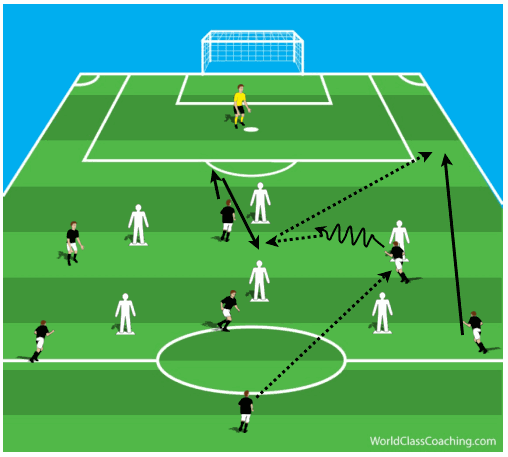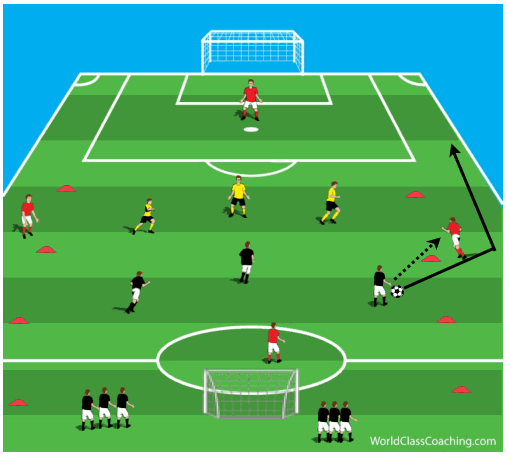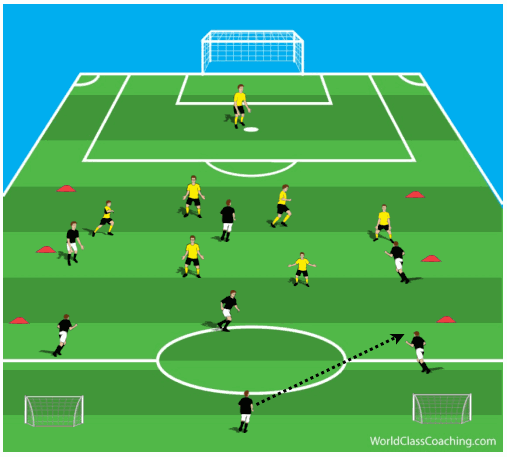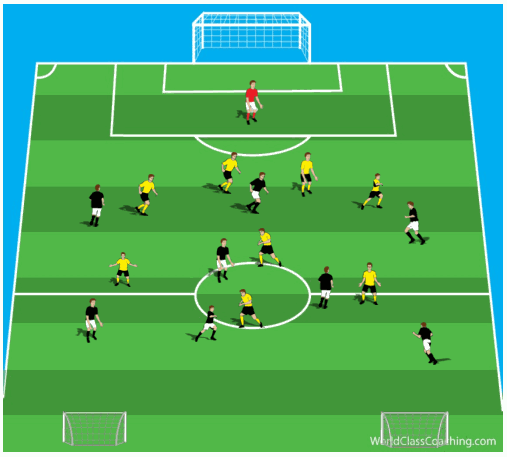By Eric Clermont -
The following session is a technically/ tactical progressive session based on teaching a team playing in a 4-3-3 formation how to effectively attack on the flanks. The session can effectively be adapted to teach a team playing in a 4-4-2 formation too.

Warm Up
Organization:
The #2, #3, #7, #8, #9, #10 and #11 are set up in a half of the field. Manakins set up in a 3-3 shape. Play always starts with #8 from halfway line. Coach teaches 3 patterns which players continue for the interval (first on the right side, then on the left side).
Patterns:
1. #8 plays to #7 (creates space by moving away and then back towards the ball), who drives inside towards the manakin (RCB). #2 overlaps and #7 can play the overlapping run or play to #9 who then plays outside to #2. Cross and finish (one set on the right, then on the left).
2. #8 plays to #2 who drives forward and plays to #9's feet, #7 runs in behind manakin (LB) and #9 finds him with a ball in between LCB and LB. Cross and finish (one set on the right, then on the left).
3. #8 plays to #2 who drives forward into space, #7 engages defender by moving away and then checks towards the ball, while #10 runs into space left by #7 (in behind LB). #2 slides ball into channel for #10. Cross and finish (one set on the right, then on the left).
Coaching Points
- Mobility of wide players to create space on the wings
- Combination play between attacking players when dealing with low/medium pressure
- Understanding of where and when to create overloads on the wings when attacking
Small Sided Activity
Organization
A goal is set up at each half of the field. Three defenders (in yellow) defend one goal for an interval and players attack that goal in waves on three at a time. One neutral player in 2 five yard zone (on each side) play with the attacking team when they are in possession. Attacking players can either pass to the neutrals from the playing area or can go in to the wide zone to combine with them. The team in black must play into a wide area before scoring. If the yellow steal the ball, they attack the opposite goal and then must react for the next wave of three attackers. When the ball goes out of bounds, a new group of 3 attackers bring their ball in to attack.
Coaching Points
- When to dribble/ when to combine
- Improvisation and creativity in 1 v 1 situations
- Different methods of combination for players

Expanded Activity
Organization
6 v 6 +GK set up in 50 x 60 yd field with a 10 yard channel on each wing. Blue team set up in a 2-1-3 formation and attack the big goal, while red team are set up in a 1-4-2 formation and play to the mini goals. Play starts from the server on each new possession(at the center of the halfway line). When attacking, the blue team can attack (through the pass/dribble) into the wide area with 2 players while the red team can defend with 1 (creating a 2 v 1). Progression: After gaining initial success, take the wide areas out so that there is open play with same number of players.
Coaching Points
- Mobility of wide players to create space on the wings.
- Combination play between attacking players when dealing with low/medium pressure
- Understanding of where and when to create overloads on the wings when attacking

Expanded Activity 2
Organization
50 x 75 yard field. 9 v 8 (team with 9 play with 8 + GK). Black team set up in a 2-3-3 formation and attack the big goal, while red team are set up in a 1-4-1-3 formation and play to the mini goals. A server starts play by playing from the back center to a blue player on the field of play.
Coaching Points
Combination play between attacking players when dealing with medium/high pressure (increased pressure due to presence of wide midfielder on wings).
Interchange of positions between players in midfield to draw defenders out of position (#7 or #11 cutting inside to leave space for an attacking mid or outside back to penetrate into space). Exploiting space that has been created by team-mates.

By Eric Clermont - NSCAA Premier Diploma, USSF A License Candidate


